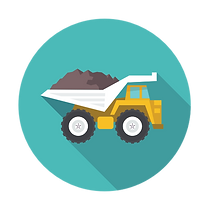
Due Diligence Guidance
for Responsible Mineral Supply Chains
Due diligence and responsibilities in the mineral supply chain

The mining, transport, and trade of mineral resources can fuel growth and employment, generate income, and promote local development. At the same time, mineral supply chain can be linked to serious human rights abuses (e.g. child labour, forced labour), money laundering, bribery, and funding for terrorism or armed groups. The OECD Due Diligence Guidance was developed to help companies avoid contributing to conflict, serious human rights impacts and financial crime through their operations or mineral sourcing practices.
How should you carry out due diligence?
Implement a risk-based approach
Companies should implement a risk-based approach to perform adequate due diligence. Activities associated with higher risks will require more intensive due-diligence and monitoring activities.

High-risk areas
Conflict-affected and other high-risk areas are characterised by institutional weakness, political instability, insecurity, armed conflict, widespread violence, or other risks of harm to people.

Adopt a progressive approach.
Due diligence is an ongoing process of gradual improvements. Companies should encourage change by engaging constructively with suppliers, including informal actors.

Conflict-affected and other high-risk areas are characterised by institutional weakness, political instability, insecurity, armed conflict, widespread violence, or other risks of harm to people.
Red flags that the minerals originated from or have been transported through a conflict-affected or high-risk area.
That the declared country of origin for minerals is one in which known mineral reserves or stocks, probable resources, or expected production levels are limited (i.e., the country's declared volumes of minerals are disproportionate to its known reserves or expected production levels).
That the minerals are declared to originate from a country through which minerals are known or reasonably suspected to be transported from conflict-affected and high-risk areas.
That the minerals are declared to be from recyclable, scrap, or mixed sources and have been refined in a country through which minerals are known or reasonably likely to be transported from conflict-affected and high-risk areas.
Make good faith efforts.
Companies are expected to take reasonable steps and make good faith efforts to carry out due diligence in their supply chains. They are not expected to achieve full compliance with the Guidance overnight.
Mitigate risks — but don’t embargo high-risk areas
Due diligence helps companies operate in or source from high-risk areas in need of responsible investment and trade. Except in the most harmful circumstances, companies should use their leverage with suppliers to improve conditions on the ground.
Based on the unusual or anomalous circumstances identified through the information collected, there is reasonable suspicion that the minerals may contribute to conflict or serious abuse, bribery, or other serious financial crime related to the extraction, transport, or trade of minerals.
Recommendations

We establish strong management systems, adopt due diligence policies, and develop the internal capacity to implement them. Interact with suppliers and business partners. Develop internal controls and transparency over the mineral supply chain, collect data, and establish mechanisms for receiving complaints.
We identify, assess and prioritize risks.
Review supply chain information to identify any red flags that require further due diligence. Deepen the analysis and map the specific circumstances of operations, supply chains, and trading partners that have generated red flags.


We manage risks by reporting results to responsible management levels and improving internal control and supervision systems. Cut ties only with suppliers associated with the greatest adverse impacts. In all other cases, take steps to gain influence, either individually or in collaboration with other actors, to avoid or minimize risks. Build internal capacity and that of trading partners.
We identify, assess and prioritize risks.
Review supply chain information to identify any red flags that require further due diligence. Deepen the analysis and map the specific circumstances of operations, supply chains, and trading partners that have generated red flags.


We publicly communicate and disclose supply chain due diligence policies, including the publication of the supply chain risk assessment and management plan, with due regard to commercial confidentiality and other competitive issues. Respond to questions, concerns, and suggestions from stakeholders.

